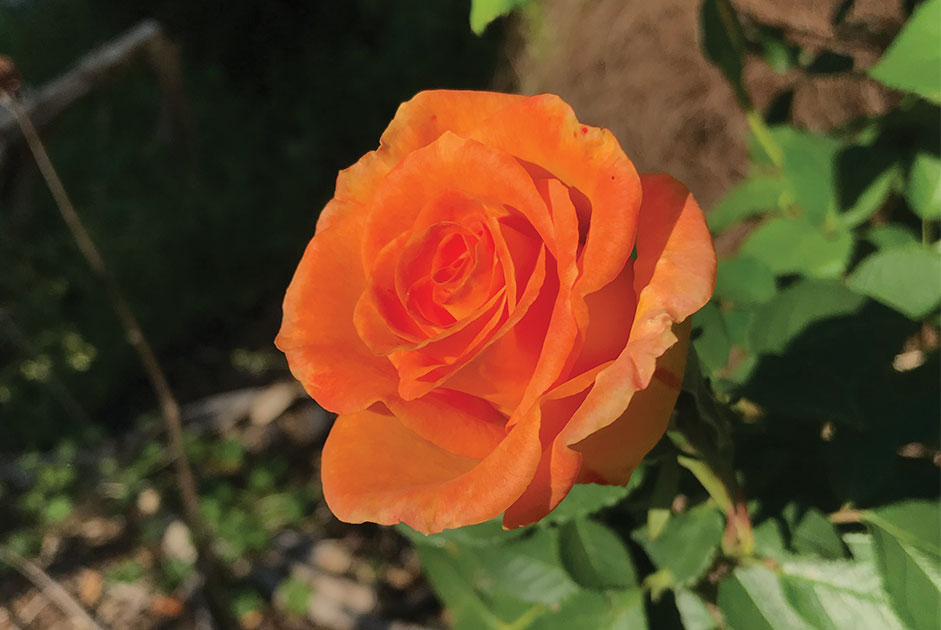The cultural knowledge of herbs is not entirely lost. Tea drinkers seek warmth through sips to find a remedy for the onset of an ailment or to relax. Once upon a time, herbal lore was instinctual, just like the hand wanders into a cupboard to find oregano written on a glass bottle. The basic knowledge of medicinal plants may still be in our genes, urging to take root and blossom. You, too, can appreciate the versatile quality of herbs by first loving plants, their colors or fragrance. Take it one step further! And, the gardener in you can make teas, salves, tinctures and poultices to promote good health!
Breathe deeply. The intoxicating scent of the rose comprises more than 300 chemical compounds, depending on the specific rose. Leaning into a yellow rose, you may notice a flavoring of violets, nasturtium and a hint of lemon. Vibrant orange petals, on the other hand, offer the scent of cloves, violets and fruit due to their mildly sedative properties. To the olfactory receptor, the queen of flowers relaxes the nerves and refreshes the spirit. It’s no wonder the rose is a celebration of beauty and love rather than a source for medicinal health.
An Infusion
In the early morning, when dew droplets rest on the petals, is the best time to capture the fragrance. We often think of the combination of rose in warm waters to soak the body; yet, there is another method that can ease heart palpitations and nervous tension, aid digestion and inflammations (gout) or resolve oily to acne-prone skin types. Try making the vitamin-enriched, rose-infused honey.
A Few Rules:
- Do not attempt with roses from a florist or sprayed with chemicals, pesticides or herbicides.
- Once removing insects, leaves and debris, choose only the best petals for your infusion.
- Start with an eight-ounce jar. If you enjoy honey in tea, drizzled over ice cream or toast, suffer from depression, or enjoy face masks, you may prefer a larger size. (Contact a local beekeeper. Honey is typically extracted and processed starting in mid-June.)
Recipe:
Fill a Mason jar ¾ full of petals. Use a spoon to compress. Pour raw, unfiltered honey to the fill line. Stir to remove air pockets. Keep the lid tight! After a few hours, stir! Leave in a warm location for four weeks, and stir occasionally. When you smell a strong aroma of rose, it’s time to strain. (May need to complete twice.) Press the roses to ensure you retain every drop! When the jar is clear of rose petals, the infusion is ready to use!
Making Rosewater
During a facial, estheticians often place a refreshing, fragrant product on the skin. Most likely, the hydrating spray was rosewater. With rose petals aplenty, why not take less than one hour to make your own?
Recipe
In a saucepan, pour three cups of filtered water with two cups of lightly packed petals. Use a small lid to submerge the contents. Over medium heat, bring to a boil; then, allow the flower to steep for 45 minutes. Strain using a fine sieve. Compost the petals. (You can freeze the rosewater in freezer bags.)
To make the toner, combine ¼ cup of witch hazel, ¼ cup of rosewater and five drops of your favorite essential oil to a small jar or spray bottle based on your application preference. Use the toner morning and night.
Growing Wild Roses
Throughout the Piedmont Triad, two native, wild species grow – the Carolina and the pasture rose. Whether appearing in a field or meadow, the pink blooms remain through late summer. Wild roses generally range from two to six feet tall and begin producing scarlet “hips” as early as July.
Tip: Wild varieties are available at nurseries; yet, stay away from hybrids.
Propagation
With a handy pair of gardening shears, consider taking six-inch cuttings. Place immediately in water and allow roots to form. Do not give up even when some existing buds or leaves turn brown. Change water frequently!
Many herbalists prefer using the petals from wild varieties to create medicinal concoctions. The untainted, purest form, perhaps, derives from the plant that lacks bright colors and intensely aromatic fragrances. For the lover of the queen of flowers, why not add a wild rose linked to history and lives?
Next Month: Lavender





















